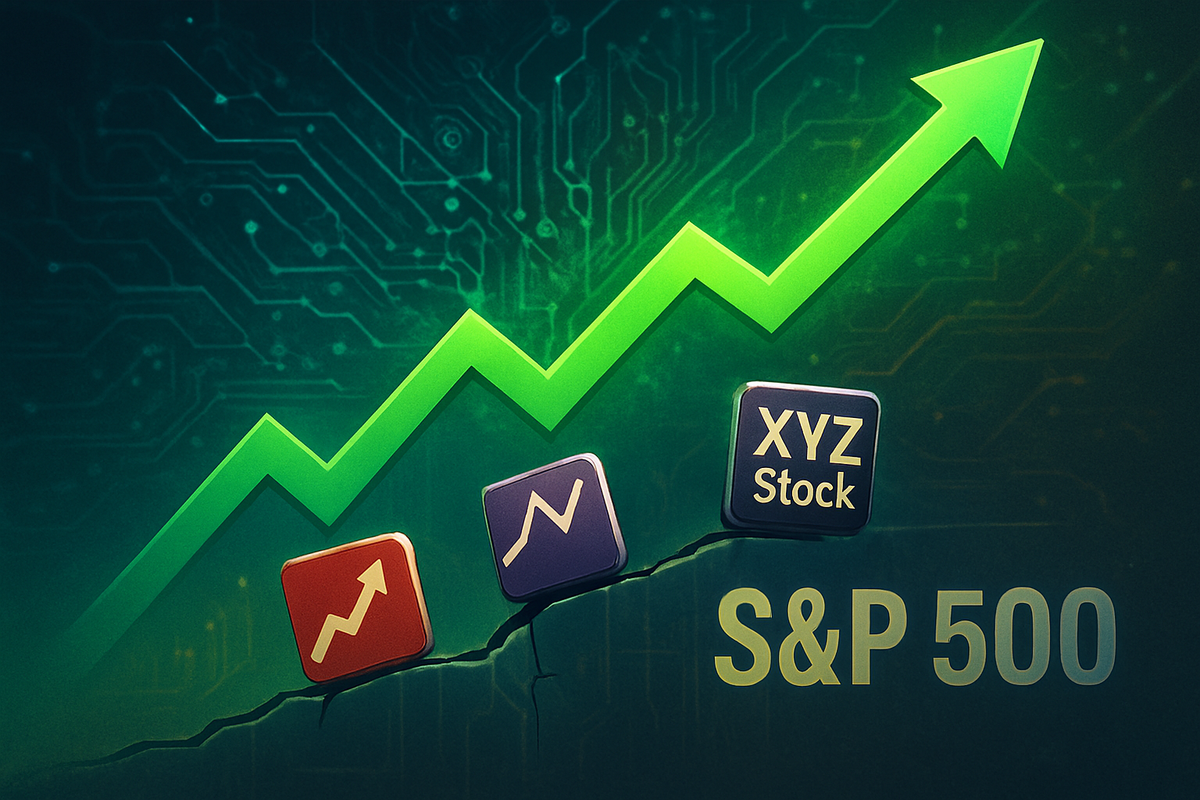
As of October 24, 2025, the S&P 500, long considered the bastion of stable American corporate power, is increasingly incorporating companies with higher risk profiles, often dubbed "dicey" or speculative stocks. This strategic shift by the S&P Dow Jones Indices committee coincides with a period of palpable market exuberance, fueled by an AI boom, record market highs, and a pervasive "fear of missing out" (FOMO) among investors. While the inclusion of these high-growth, high-volatility companies can offer immediate boosts to their valuations and broaden the index's representation of emerging sectors, it simultaneously introduces heightened risk and potential instability to the benchmark index, raising concerns about its susceptibility to future corrections.
This trend signifies a notable departure from the S&P 500's traditional conservative approach, signaling an adaptation to a market environment where speculative trading and rapid technological advancements are driving significant capital flows. The immediate implication is a potentially more volatile S&P 500, one that could experience larger swings in value, impacting the portfolios of countless investors, particularly those heavily invested in passive index funds. The market's current elevated valuations, coupled with this embrace of riskier assets, sets the stage for a critical examination of the index's future trajectory and the broader health of the financial markets.
The Shifting Sands of S&P 500 Inclusion
The S&P Dow Jones Indices committee, responsible for maintaining the integrity and relevance of the S&P 500, adheres to stringent criteria for inclusion, including substantial market capitalization (currently $22.7 billion), high liquidity, and consistent positive GAAP earnings. However, recent adjustments and the prevailing market sentiment have demonstrably created an environment where companies with a history of significant price swings and strong retail investor interest are finding their way into this elite index. This shift is not merely coincidental but reflects a market grappling with unprecedented technological shifts and evolving investor behavior.
A timeline of recent inclusions highlights this trend. In September 2024, Palantir Technologies (NYSE: PLTR), an AI-focused data analytics firm popular with retail investors, was added. This was followed by Super Micro Computer (NASDAQ: SMCI) in March 2023, a company that became one of the most volatile S&P 500 names in 2024 due to its AI-driven surge. More recently, on September 22, 2025, Robinhood Markets (NASDAQ: HOOD), a brokerage intrinsically linked to the "meme stock" phenomenon and retail speculative trading, joined the index. Other notable additions in 2025 include DoorDash (NYSE: DASH), TKO Group Holdings (NYSE: TKO), Williams-Sonoma (NYSE: WSM), and Expand Energy (NYSE: EXE) in March, and AppLovin (NASDAQ: APP), Emcor Group (NYSE: EME), and Interactive Brokers Group (NASDAQ: IBKR) in August and September. These additions, particularly those with a history of higher volatility or connections to past speculative frenzies, underscore the committee's willingness to incorporate companies traditionally perceived as more speculative. The lowering of the float-adjusted liquidity ratio (FALR) requirement to 0.75, effective January 4, 2023, also likely facilitated the inclusion of more actively traded, albeit volatile, stocks.
Key players in this unfolding narrative include the S&P Dow Jones Indices committee, whose qualitative judgment beyond objective criteria plays a significant role; the companies themselves, who gain immense prestige and investment flows upon inclusion; and, crucially, both retail and institutional investors. Initial market reactions have been mixed. While some view these inclusions as a necessary evolution of the index to reflect modern market dynamics and growth sectors, others express deep concern. The presence of these "dicey stocks" is seen by some as legitimizing the market's increasingly adventurous appetite, potentially fueling further retail speculation and increasing the index's overall risk profile.
Winners and Losers in a Speculative Market
The inclusion of these higher-risk companies in the S&P 500 creates clear winners and potential losers. The most immediate beneficiaries are the newly added companies themselves. For companies like Robinhood Markets (NASDAQ: HOOD), Palantir Technologies (NYSE: PLTR), and Super Micro Computer (NASDAQ: SMCI), inclusion guarantees mandatory buying by index funds and ETFs tracking the S&P 500. This "index effect" often leads to a short-term price boost, increased trading liquidity, and enhanced corporate prestige, making them more attractive to a broader institutional investor base. This influx of capital and validation can provide these companies with greater financial flexibility for growth and expansion, reinforcing their market positions.
However, the "index effect" is often temporary, with studies indicating no permanent benefit without strong underlying fundamentals. The real challenge arises for investors in passive S&P 500 index funds. While these funds benefit from diversification, the increased presence of volatile, growth-oriented companies means their portfolios are now exposed to higher levels of risk. If a market correction occurs, these "dicey" stocks, often characterized by high valuations relative to earnings and greater sensitivity to economic downturns or shifts in sentiment, could experience sharper declines, dragging down the entire index. This could lead to significant paper losses for investors who believed they were invested in a traditionally stable benchmark.
Furthermore, the shift could indirectly affect traditional blue-chip companies within the S&P 500. As funds flow into the newer, more speculative additions, the relative weight and perhaps even the perceived stability of established firms could subtly diminish. While unlikely to cause direct losses for these stalwarts, it could alter the overall risk-return profile of the S&P 500, making it less predictable than in previous eras. Ultimately, the market as a whole could lose if this trend contributes to an unsustainable bubble, leading to a widespread downturn that impacts all sectors.
Broader Implications and Historical Echoes
This trend of the S&P 500 embracing higher-risk assets during a period of market exuberance fits squarely into broader industry trends characterized by a relentless pursuit of growth, often at the expense of traditional value metrics. The AI boom, in particular, has driven a narrative where future potential outweighs current profitability, leading to stretched valuations across the technology sector. This phenomenon is indicative of a market that is increasingly prioritizing disruptive innovation and speculative bets over established, stable earnings.
The ripple effects could be significant. Competitors of the newly included "dicey" stocks might face increased pressure as their rivals gain access to a broader, more stable investor base and the associated prestige. Conversely, partners or suppliers to these high-growth companies could see increased demand for their services. From a regulatory perspective, the heightened concentration risk within the S&P 500, with mega-cap tech firms accounting for a substantial portion of the index, could attract greater scrutiny. The International Monetary Fund (IMF) has already warned in October 2025 that the U.S. stock market risks a "sudden, sharp correction" due to gains concentrated in these mega-cap firms, whose valuations may not be justified by future returns. This could lead to discussions about market manipulation, investor protection, or even anti-trust concerns if the dominance of a few companies becomes too pronounced.
Historically, periods of intense market exuberance, especially when accompanied by the inclusion of high-flying, speculative stocks in major indices, have frequently preceded significant market corrections. Parallels are often drawn to the late 1990s dot-com bubble, where "irrational exuberance," as famously coined by Alan Greenspan, led to the inclusion of many unproven tech companies in major indices, only to see them collapse spectacularly. The current market's elevated P/E ratio (around 31 as of October 2025), record-high "Buffett Indicator" (219%), and near-record Shiller CAPE Ratio all signal "stretched valuations," echoing the conditions seen before past market downturns. The "too much complacency regarding risk" observed in the market as of October 2025 further amplifies these historical warnings.
Navigating the Path Ahead
Looking ahead, the short-term possibilities suggest a continuation of the current market trajectory, at least for a while. The prevailing bullish sentiment, driven by hopes of imminent interest rate cuts and the ongoing AI narrative, could sustain the market's upward momentum. The "index effect" from recent inclusions might continue to provide some support for the newly added "dicey" stocks. However, this exuberance is built on increasingly fragile foundations. In the long term, the market's elevated valuations and the increased presence of volatile assets heighten the probability of a significant correction.
Potential strategic pivots will be crucial for both institutional and retail investors. Institutional investors, who are already showing more caution and reducing exposure to overvalued tech and financials, might continue to hedge their bets, potentially shifting towards more defensive sectors or increasing their cash positions. Retail investors, currently characterized by a "buy the dip" mentality, may need to re-evaluate their risk tolerance and diversify their portfolios beyond heavily concentrated growth stocks. Market opportunities may emerge in sectors that have been overlooked during the current growth frenzy, such as value stocks or international markets, should a rotation occur. Conversely, the major challenge remains the potential for a sudden, sharp correction that could wipe out significant gains for those overexposed to speculative assets.
Several scenarios could unfold. The market could continue its ascent, defying gravity for an extended period, perhaps fueled by continued strong corporate earnings and genuine technological breakthroughs. Alternatively, a catalyst – such as an unexpected rise in inflation, a more hawkish stance from central banks, or geopolitical instability – could trigger a rapid unwinding of speculative positions, leading to a sharp downturn. A third scenario involves a more gradual cooling off, where valuations slowly normalize without a catastrophic crash. The current divergence between bullish retail sentiment and cautious institutional behavior suggests that the market is at a critical juncture, with multiple outcomes possible.
A Market at a Crossroads
In summary, the S&P 500's recent embrace of "dicey" stocks amidst a period of intense market exuberance marks a significant moment in financial history. While it reflects the dynamic nature of the market and the rise of new, innovative companies, it also introduces substantial risk to what has traditionally been a benchmark of stability. Key takeaways include the legitimization of speculative assets within the mainstream, the increased volatility and concentration risk now embedded in the index, and the stark parallels to historical periods of "irrational exuberance" that preceded significant market corrections.
Moving forward, the market appears to be at a crossroads. The current environment of record highs, stretched valuations, and widespread FOMO cannot be sustained indefinitely without a fundamental re-evaluation. The divergence in sentiment between retail and institutional investors further underscores the precarious balance. While the immediate future might see continued buoyancy, the long-term outlook is clouded by the specter of a potential "sudden, sharp correction" as warned by the IMF.
Investors should watch for several key indicators in the coming months: any shifts in central bank policy regarding interest rates, changes in inflation data, corporate earnings reports (especially from the mega-cap tech firms), and any signs of a cooling in retail investor enthusiasm. A critical assessment of one's portfolio risk, diversification, and a focus on fundamentals rather than pure speculation will be paramount. The S&P 500, in its current form, is a more adventurous beast than its predecessors, and understanding its evolving nature is essential for navigating the complex financial landscape ahead.
This content is intended for informational purposes only and is not financial advice





